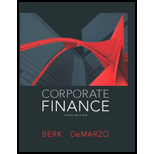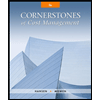
Corporate Finance
3rd Edition
ISBN: 9780132992473
Author: Jonathan Berk, Peter DeMarzo
Publisher: Prentice Hall
expand_more
expand_more
format_list_bulleted
Concept explainers
Textbook Question
Chapter 27.4, Problem 1CC
What is commercial paper?
Expert Solution & Answer
Want to see the full answer?
Check out a sample textbook solution
Students have asked these similar questions
Which financial statement shows a company's financial position at a specific point in time?A) Income statementB) Statement of cash flowsC) Balance sheetD) Statement of retained earnings
In finance, diversification is used to:A) Increase expected returnsB) Minimize transaction costsC) Reduce unsystematic riskD) Eliminate all risksexplain
In finance, diversification is used to:A) Increase expected returnsB) Minimize transaction costsC) Reduce unsystematic riskD) Eliminate all risks
Chapter 27 Solutions
Corporate Finance
Ch. 27.1 - Prob. 1CCCh. 27.1 - What is the effect of seasonalities on short-term...Ch. 27.2 - Prob. 1CCCh. 27.2 - What is the difference between temporary and...Ch. 27.3 - Prob. 1CCCh. 27.3 - Describe common loan stipulations and fees.Ch. 27.4 - What is commercial paper?Ch. 27.4 - How is interest paid on commercial paper?Ch. 27.5 - Prob. 1CCCh. 27.5 - What is the difference between a floating lien and...
Ch. 27 - Prob. 1PCh. 27 - Sailboats Etc. is a retail company specializing in...Ch. 27 - What is the difference between permanent working...Ch. 27 - Quarterly working capital levels for your firm for...Ch. 27 - Prob. 5PCh. 27 - Prob. 6PCh. 27 - Prob. 7PCh. 27 - Prob. 8PCh. 27 - Which of the following one-year 1000 bank loans...Ch. 27 - The Needy Corporation borrowed 10,000 from Bank...Ch. 27 - Prob. 11PCh. 27 - Prob. 12PCh. 27 - Prob. 13PCh. 27 - The Signet Corporation has issued four-month...Ch. 27 - Prob. 15PCh. 27 - Prob. 16PCh. 27 - Prob. 17PCh. 27 - Prob. 18P
Knowledge Booster
Learn more about
Need a deep-dive on the concept behind this application? Look no further. Learn more about this topic, finance and related others by exploring similar questions and additional content below.Similar questions
- The internal rate of return (IRR) is:A) The discount rate that makes the net present value (NPV) of a project zeroB) The rate of return required by investorsC) The interest rate on a bank loanD) The growth rate of dividendsexplainarrow_forwardThe internal rate of return (IRR) is:A) The discount rate that makes the net present value (NPV) of a project zeroB) The rate of return required by investorsC) The interest rate on a bank loanD) The growth rate of dividendsarrow_forwardWhich of the following is considered a risk-free investment?A) Corporate bondsB) Common stockC) Treasury billsD) Mutual fundsexplain.arrow_forward
- Which of the following is considered a risk-free investment?A) Corporate bondsB) Common stockC) Treasury billsD) Mutual fundsarrow_forwardHello submitted blurr image please comment i will write values. please dont Solve with incorrect values otherwise unhelpful.arrow_forwardWhat does the beta of a stock measure?A) The company’s profitabilityB) The volatility of the stock compared to the marketC) The dividend payout ratioD) The time value of moneyexplain.arrow_forward
- Which of the following is an example of a capital budgeting decision?A) Deciding how much inventory to holdB) Choosing which long-term project to invest inC) Determining how to finance a short-term loanD) Managing daily cash flow explain.arrow_forwardWhat does the beta of a stock measure?A) The company’s profitabilityB) The volatility of the stock compared to the marketC) The dividend payout ratioD) The time value of moneyarrow_forwardWhich of the following is an example of a capital budgeting decision?A) Deciding how much inventory to holdB) Choosing which long-term project to invest inC) Determining how to finance a short-term loanD) Managing daily cash flowarrow_forward
- What is the formula for the present value of a single future cash flow?A) FV × (1 + r)^nB) FV ÷ (1 + r)^nC) FV × r × nD) FV × (1 - r)^nexplain.arrow_forwardWhat is the formula for the present value of a single future cash flow?A) FV × (1 + r)^nB) FV ÷ (1 + r)^nC) FV × r × nD) FV × (1 - r)^narrow_forwardThe time value of money concept is based on the idea that:A) A dollar today is worth less than a dollar in the futureB) A dollar today is worth more than a dollar in the futureC) Money loses value over time due to inflationD) Future cash flows have no value Explain.arrow_forward
arrow_back_ios
SEE MORE QUESTIONS
arrow_forward_ios
Recommended textbooks for you
- Century 21 Accounting Multicolumn JournalAccountingISBN:9781337679503Author:GilbertsonPublisher:CengagePrinciples of Accounting Volume 2AccountingISBN:9781947172609Author:OpenStaxPublisher:OpenStax College
 Cornerstones of Cost Management (Cornerstones Ser...AccountingISBN:9781305970663Author:Don R. Hansen, Maryanne M. MowenPublisher:Cengage LearningPrinciples of Accounting Volume 1AccountingISBN:9781947172685Author:OpenStaxPublisher:OpenStax College
Cornerstones of Cost Management (Cornerstones Ser...AccountingISBN:9781305970663Author:Don R. Hansen, Maryanne M. MowenPublisher:Cengage LearningPrinciples of Accounting Volume 1AccountingISBN:9781947172685Author:OpenStaxPublisher:OpenStax College

Century 21 Accounting Multicolumn Journal
Accounting
ISBN:9781337679503
Author:Gilbertson
Publisher:Cengage


Principles of Accounting Volume 2
Accounting
ISBN:9781947172609
Author:OpenStax
Publisher:OpenStax College

Cornerstones of Cost Management (Cornerstones Ser...
Accounting
ISBN:9781305970663
Author:Don R. Hansen, Maryanne M. Mowen
Publisher:Cengage Learning

Principles of Accounting Volume 1
Accounting
ISBN:9781947172685
Author:OpenStax
Publisher:OpenStax College
What are Money Markets?; Author: The CISI;https://www.youtube.com/watch?v=ipOYM0sfW7M;License: Standard Youtube License